This week The Pull List is holding steady at a still-staggering 32 comic books.
I’m not sure if I was being a moody reader or if every company shipped some bunk books this week, but the average rating for the week was 2.70 – a full third of a point lower than the past few weeks. While that means most of the books were still better than average, it’s not by a whole lot.
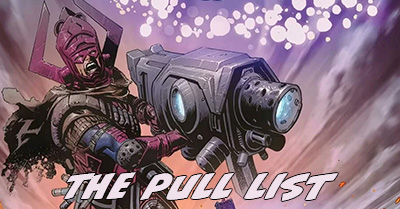
Artwork from Thanos #16, line art by Geoff Shaw with color art by Antonio Fabela.
Here’s what I pulled this week, with *s on adds (whether I just caught up with them or started them fresh):
- DC Comics
- Action Comics #998
- Detective Comics #975
- The Flash #41
- * Mera – Queen of Atlantis #1
- Milk Wars: JLA/Doom Patrol Special
- Raven: Daughter of Darkness #2
- * Suicide Squad #36
- Teen Titans #17
- The Silencer #2
- * The Terrifics #1
- Wonder Woman #41
- Image Comics
- * The Beef #1
- Days of Hate #2
- Gasolina #6
- Twisted Romance #4
- Void Trip #4
- Marvel Comics
- All-New Wolverine #31
- Avengers #682
- Captain Marvel #129
- * Champions #17
- Legion #2
- * Lockjaw #1
- Moon Knight #192
- Thanos #16
- X-Men Blue #22
- Smaller Publishers: Aftershock, Black Mask, Boom! Studios, Dark Horse, Titan
- Abbott #2, Boom! Studios
- * Alisik #1, Titan Books / Statix Press
- Backways #3, Aftershock Comics
- * Calexit #2, Black Mask Studios
- Hungry Ghosts #2, Dark Horse / Berger Books
- * Jim Henson’s Labyrinth: Coronation #1, Boom! Studios
- * The Wilds #1, Black Mask Studios
Picks of the Pull
Big Two (Marvel/DC) Issue of the Week:
Detective Comics (2016) #975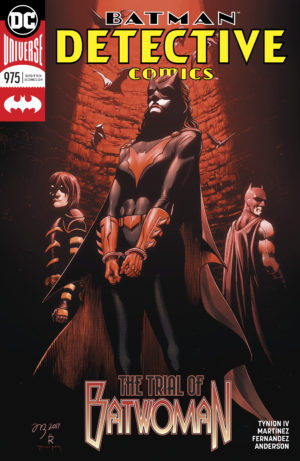
![]() A great-looking, contemplative issue that brings together the members of the Bat-Family we don’t usually see in this book – Nightwing, Batgirl, Red Hood, and Damian.
A great-looking, contemplative issue that brings together the members of the Bat-Family we don’t usually see in this book – Nightwing, Batgirl, Red Hood, and Damian.
Batman has pulled these trusted lieutenants together as an inner council to decide Batwoman’s fate as a member of the Bat-family, yet in some ways their conversation is also a litigation of Bruce and his methods as the head of this dysfunctional household. Meanwhile, Batwoman holds herself accountable for her own actions, with a surprising result.
This isn’t an issue that’s going to appeal to a more casual reader – it looks amazing, but it has hardly any conflict. However, for someone who has been reading from the start this pierces right to the heart of this title and the ideological divide between Batwoman and Batman that has been brewing all along.
Part of what makes it so power is that Batwoman also has an avowed “no kills” philosophy, but she is willing to make exceptions when other lives hang in the balance. Batman won’t make exceptions, so he gets to watches thousands of Gothamites die from his moral high ground.
It’s heartbreaking to think of this book writing by someone other than Tynion or with a cast other than this one. Everything about it works so incredibly well. Yet, we’re in the “disassembled” phase, and there’s certainly more conflict to come before Tynion moves on.![]()
Best Small-Pub Issue of the Week:
The Wilds (2018) #1, Black Mask Studios
![]() A strong and sombre new zombie comic, The Wilds is definitely a descendent of Walking Dead but with a completely different tone – due in no small part to its pair of woman creators, Vita Ayala and Emily Pearson.
A strong and sombre new zombie comic, The Wilds is definitely a descendent of Walking Dead but with a completely different tone – due in no small part to its pair of woman creators, Vita Ayala and Emily Pearson.
We get the same old zombie-pocked landscape with isolated camps trading resources and doing their best to survive, except the zombies are walking plant life – humans who have turned into semi-sentient flower pots. It makes for strangely calming, beautiful zombies to see all of their typical goriest bits covered in blooming flowers.
Pearson’s art evokes such masters of the modern form as Allred and Noto, employing their same plain, truthful faces and uncomplicated backgrounds.
Beneath the flowery dressing, this is the familiar story of a single senior errand runner who thinks it might be time to get out of the game, and how an act of compassion on her last journey might spell the end of the safety of her heavily fortified compound. There’s no slam bang action beats in this one, but the strange stillness of it is pulling me towards reading more.
![]()
DC Comics
Action Comics (2016) #998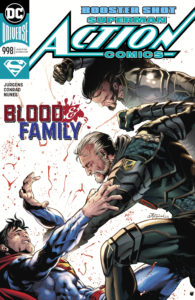
![]() Superman wraps up his jaunt through time with Booster Gold to try to understand how a certain Kryptonian (other than Zod) eluded the destruction of their planet to stalk Superman to the present day.
Superman wraps up his jaunt through time with Booster Gold to try to understand how a certain Kryptonian (other than Zod) eluded the destruction of their planet to stalk Superman to the present day.
Will Conrad is one of my favorite interiors artists, and even time he appears on a Superman title he just gets better. He reminds me of Mike Deodato from 15 or 25 years ago, who still liked to play with black on the page but drew bigger, bolder figures. Conrad’s Superman is massive and massively handsome, and his action is explosive. This arc should have split duties between the two plots and two pencillers instead of alternating between them.
Despite the amazing artwork from Conrad, I could barely pay attention to reading this issue – I kept wandering away from the computer as I tried to finish it. This arc has been a lot of fun, but the dramatic tension of this final installment was off – even with some major time shenanigans to avoid an even more major potential death. A fight against Zod in the future has absolutely zero gravity, and it turns out the Lois and Jon plot didn’t either.
We did come out of this arc with some net gain. Superman has at least a partial answer on how someone else was able to escape Krypton at the final moments, and Lois Lane has reconnected with a character who had been out of her life. That gives us more fuel for the big conclusion of this amazing run in #1000, and more toys for Brian Bendis to play with afterwards.![]()
Mera – Queen of Atlantis (2018) #1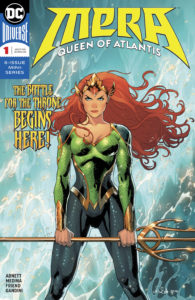
![]() I’m coming to this series having not yet caught up on the current Dan Abnett run of Aquaman. While I think it offered plenty of explanation of Mera’s current status quo, some of my reaction might be because the events of this issue just didn’t hit me the way they would for a current Aquaman reader.
I’m coming to this series having not yet caught up on the current Dan Abnett run of Aquaman. While I think it offered plenty of explanation of Mera’s current status quo, some of my reaction might be because the events of this issue just didn’t hit me the way they would for a current Aquaman reader.
This fills in some history on Mera and shows of her mental and physical toughness, but it ends without telegraphing why it needs to exist. That’s a critical flaw for a mini-series, which doesn’t have the time to unfold the way an ongoing does. The main cliffhanger between here and the next issue is mostly Orm’s, and the issue does a much poorer job of explaining him or his connection to Mera.
Abnett does pull off one neat trick, which is overtly telling the reader that Mera is a character with agency and it actually working. He does this by having Mera herself muse on if she has any control over her life even as she takes control of a fight that been getting the best of her. It’s a neat defusing of the critique that we’re getting a starring turn from Mera while she is wounded and separated from her partner. If she feels like she still has power and agency, who are we as readers to disagree?
Ultimately, it’s a flat first issue more about information than excitement. Perhaps Orm’s plans will help shake up the plot in the next installment.![]()
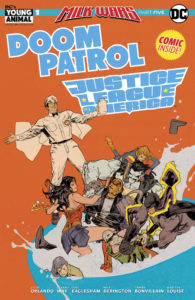 Milk Wars, Part 5: JLA / Doom Patrol Special
Milk Wars, Part 5: JLA / Doom Patrol Special
![]() I think this final installment of Milk Wars really nails the tone this crossover has been striving for all along – a parody of madcap Silver Age ridiculousness that is also actual madcap Silver Age ridiculousness.
I think this final installment of Milk Wars really nails the tone this crossover has been striving for all along – a parody of madcap Silver Age ridiculousness that is also actual madcap Silver Age ridiculousness.
The issue is incredibly lovely, as all of these Milk Wars comics have been. Dale Eaglesham and Nick Derington have to handle a lot of characters here, and they go above and beyond simply keeping them on-model. The entire assembled JLA and Doom Patrol crash through the RetConn headquarters trying to right the lactose-infused wrongs of reality.
The last two installments of Milk Wars have definitely been the most fun for me, and I think that’s because they are more explicit in identifying the conflict within the story – whereas the first three parts were more about making light of the Young Animal characters they starred.
On the whole, I have a hard time recommending them to anyone but readers of Doom Patrol, or maybe Cave Carson. None of the DC characters are well-served or have significant moments, and Young Animal’s Mother Panic and Shade only glancingly connect to their ongoing versions. I’m not caught up on Young Animal’s line of books, but the end of this issue seem to give all of Young Animal’s continuity a slight reboot at the close, whereas it has no impact to the JLA, Batman, or Wonder Woman.![]()
Raven: Daughter of Darkness (2018) #2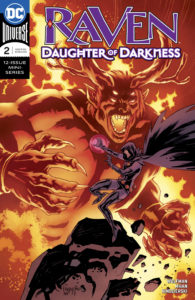
![]() This is a well-made an enjoyably comic book. Marv Wolfman hasn’t lost his touch in the modern day, and the artwork from Pop Mhan is lovely.
This is a well-made an enjoyably comic book. Marv Wolfman hasn’t lost his touch in the modern day, and the artwork from Pop Mhan is lovely.
Raven’s multiple encounters with a big-eyed, no-mouthed attacker here are creepy, but she maintains her sensitivity to the girl’s plight through each one – she cannot help but worry about how she breathes or speaks.
DC’s obstinate refusal to use recap pages is really hurting this series for me as a newer reader, as it’s hard to understand what concepts are brand new and which are grounded in past series. I feel like I’m getting a lot about Raven’s character here; I just wish I understood the story a bit better.![]()
Suicide Squad (2016) #36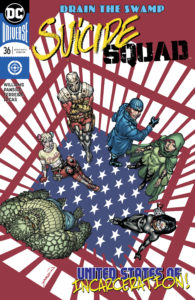
![]() Suicide Squad is BACK! After a long, meandering set of issues since last winter’s crossover with Justice League, this issue looks amazing and has the team dealing with a plot that’s been simmering since just after that event in issue #13.
Suicide Squad is BACK! After a long, meandering set of issues since last winter’s crossover with Justice League, this issue looks amazing and has the team dealing with a plot that’s been simmering since just after that event in issue #13.
We already know the identity of the killer that’s being sought here, and so do a few members of the squad. That takes the tension in this story to a “we already know but the characters don’t” place that can feel like a bit of a drag. However, there are some other aspects to this story keeping it interesting, including Rick Flag returning to Belle Reve with his new superhero in tow and Waller being willing to sacrifice the entire prison if it means keeping her secrets from coming to light.
This doesn’t have too many character moments for the Squad itself, but it is still satisfying closure on nearly a year of comic stories – plus, it looks great.![]()
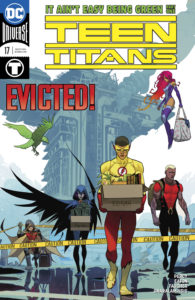 Teen Titans (2016) #17
Teen Titans (2016) #17
![]() This Beast Boy solo tale is a basic story, but there are a lot of elements that make it stand out. The team working together. The use of the SF geography. Beast Boy’s happening upon a strange tech bubble of discarded teens. Plus, Scott Eaton’s more grown-up art for this arc not focused on Robin. It all adds up to something a little more than the sum of its parts – and a story that seems like it will give Beast Boy some warranted development.
This Beast Boy solo tale is a basic story, but there are a lot of elements that make it stand out. The team working together. The use of the SF geography. Beast Boy’s happening upon a strange tech bubble of discarded teens. Plus, Scott Eaton’s more grown-up art for this arc not focused on Robin. It all adds up to something a little more than the sum of its parts – and a story that seems like it will give Beast Boy some warranted development.![]()
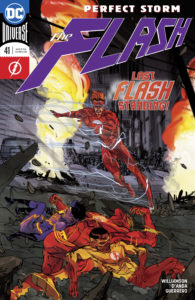 The Flash (2016) #41
The Flash (2016) #41
![]() This advances the tense standoff between the Flashes and Grodd along with Reverse Flash. It winds up being yet another great feature for OG Wally. Writer Joshua Williamson clearly has some affection for the character.
This advances the tense standoff between the Flashes and Grodd along with Reverse Flash. It winds up being yet another great feature for OG Wally. Writer Joshua Williamson clearly has some affection for the character.
What’s really impressive here is all of the many ties to the earliest arcs of this series, including an ending that goes right back to the first issue. It’s not just the level of continuity that introduces, but the feeling of “using every part of the cow” in that Williamson is really intent on making every single plotline count to the fullest. That, combined with strong artwork, makes for yet another terrific issue of this series.![]()
The Silencer (2018) #2
![]() JRJR is in a comfort zone here with tight shots of 1:1 physical action, but there are still so many weird choices in this book that I cannot helped but be boggled as I read it.
JRJR is in a comfort zone here with tight shots of 1:1 physical action, but there are still so many weird choices in this book that I cannot helped but be boggled as I read it.
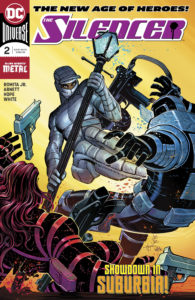
Did he just… not design a costume for Silencer? It is the most unpleasing and lumpy suit topped with a padded trucker hat, and the grey and blue/green colors do it no favors. Add to that a glaring set of colors, weird stick figure bodies with giant round heads, and obvious editing mishaps (the plural of Chris is Chrises, not Chris’ – have you EVER proofread before?!), and it’s hard to find the story within the comedy of errors.
That story is Silencer used to be a Leviathan operative with the power to create bubbles of silence, but now she’s living the suburban life and she wants out for good despite them trying to pull her back in.
I can’t decide if there is a plot here that I’d want to read if I wasn’t grimacing at almost every panel of art. I’m usually a big fan of female superheroes, but the inner monologue in this book has a flatness to it and the character is ultimately so shallow that I find myself having a hard time caring.![]()
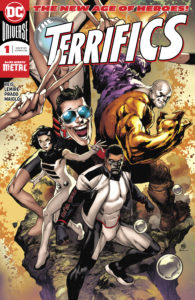 The Terrifics (2018) #1
The Terrifics (2018) #1
![]() The Terrifics is the best thing to come out of DC Metal, full stop. It graduates from all of Metal’s crazy themes, but ties them up with a simple little bow and gets back to the characters at its heart – in this case, Mr. Terrific and Plastic Man, joined by Metamorpho. Jeff Lemire and Ivan Reis mash them up in a beautiful riff on the Fantastic Four and old pulp science adventures that proceeded it.
The Terrifics is the best thing to come out of DC Metal, full stop. It graduates from all of Metal’s crazy themes, but ties them up with a simple little bow and gets back to the characters at its heart – in this case, Mr. Terrific and Plastic Man, joined by Metamorpho. Jeff Lemire and Ivan Reis mash them up in a beautiful riff on the Fantastic Four and old pulp science adventures that proceeded it.
I’m guardedly optimistic about this one – Lemire hasn’t done a lot of work that excites me in the past five years, and doing boring things with unlikely casts of characters is sort of his speciality. Maybe with the long and storied history of the Fantastic Four to work from he can manage to conjure an interesting tale here.![]()
Wonder Woman (2016) #41
![]() This script is a turd. The first half is all Darksied, and when Wonder Woman and Steve Trevor show up their dialog is wooden (“destructive AND deadly”).
This script is a turd. The first half is all Darksied, and when Wonder Woman and Steve Trevor show up their dialog is wooden (“destructive AND deadly”).
Why are we getting flashbacks to great, perilous, heroic fights (“dangerous AND deadly,” by gods the dialog was bad) when we could be seeing them occur as they happen? Why does no one know how to write a Wonder Woman comic book!?
Granted, it did look great and the lettering wasn’t quite as unreadable as its been recently, but it was a bad comic book.![]()
Image Comics
The Beef (2018) #1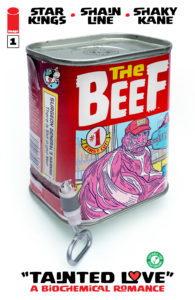
![]() This comic book intentionally unpleasant. Not just a little bit uncomfortable, but thoroughly annoying.
This comic book intentionally unpleasant. Not just a little bit uncomfortable, but thoroughly annoying.
I’m pretty sure that was the point. We’re seeing a heroic origin story that’s a parody of all of the worst tropes of Marvel’s Silver Age. The orphan. The bullies. The racism and sexism. The average life suddenly elevated to something more. It’s carefully designed to give us maximum sympathy with our dead-eyed hero and his inner life, as rendered in the lurid style of classic EC Comics artwork.
I don’t tend to respond well to these sorts of stories. You can tell me a character’s life was awful, but I don’t necessarily need to sit through a lot of you showing it to me. It often turns into a game of misfortune porn, where we’re supposed to take some small, hidden delight in the terrible, degrading behavior that surrounds our hero. Better them than us, right?!
We’re obviously meant to be laughing at and not with the awful disease of hatred shot through this small, slaughterhouse town, but even laughing at it wasn’t much fun. It’s clear that this book is going to quickly turn to give the town its own chemically imbalanced avenger who will also get his own love story with this issue’s put-upon damsel.
If you like horrible people getting their just desserts and parody turned up so loud that it blows the speakers, then the next four issues of this series are going to be a delight.![]()
Days of Hate (2018) #2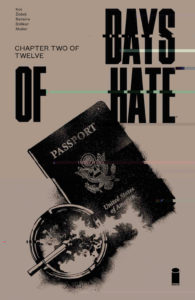
![]() I love Ales Kot and almost universally enjoy his comics, but there’s no spark in this one. It feels as though he imagined this version of America slightly fictionalized from the present day to a more pronounced dystopia purely to make say things he was planning to tweet about anyway.
I love Ales Kot and almost universally enjoy his comics, but there’s no spark in this one. It feels as though he imagined this version of America slightly fictionalized from the present day to a more pronounced dystopia purely to make say things he was planning to tweet about anyway.
We are in the wake of the terrorist bombing of a club full of Nazis. The pair of liberal terrorists are holed up in a hotel room talking about beers and ICE in a way that is eerily present. That’s about all there is here, aside from some filler scenes with a pair of other characters. It feels like we could stand to learn more about this world to make the microcosm of the journey of this specific group of people more interesting.
The artwork solidifies a bit in this issue – it’s still got a rough, charcoal-drawn feel to it, but the roughness is more reigned in and attractive.![]()
Gasolina (2017) #6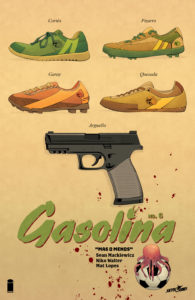
![]() This issue is a pretty big departure from the ones before it – it entirely follows the police detective, with only the slightest connection to our protagonists from prior issues. To release this issue before a month of hiatus is a dangerous game.
This issue is a pretty big departure from the ones before it – it entirely follows the police detective, with only the slightest connection to our protagonists from prior issues. To release this issue before a month of hiatus is a dangerous game.
It looks terrific. It’s not only the best the art has been since issue one, but the art also does a lot of heavy-lifting in the storytelling department, conveying a lot of the script in facial acting and motion.
The Detective’s investigation of a mass murder and his tracking down of its perpetrators might be the good start of a fresh arc, but as the completion of this first arc it’s really lacking. I found myself asking the entire time, “but, why should I care?” It carries forward nothing that’s been intriguing about this book to date, which makes it easy to forget the positive qualities of what came before.![]()
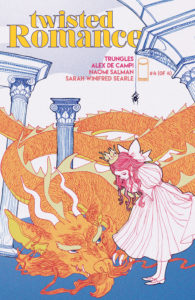 Twisted Romance (2018) #4
Twisted Romance (2018) #4
![]() An impossibly gorgeous full-length fairytale from Trungles and Alex de Campi. If it wasn’t for the risqué prose story in the back matter I’d buy this issue for my 4.5YO to read and appreciate.
An impossibly gorgeous full-length fairytale from Trungles and Alex de Campi. If it wasn’t for the risqué prose story in the back matter I’d buy this issue for my 4.5YO to read and appreciate.![]()
Void Trip (2017) #4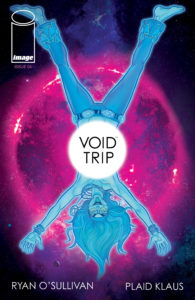
![]() This issue feels like the briefest chapter of this groovy slice of outerspace psychedelia heavily influenced by the Hitchhiker’s Guide to the Galaxy. If last issue was the comedown after a euphoric high, this issue is the return to mundanity that follows.
This issue feels like the briefest chapter of this groovy slice of outerspace psychedelia heavily influenced by the Hitchhiker’s Guide to the Galaxy. If last issue was the comedown after a euphoric high, this issue is the return to mundanity that follows.
What’s it like to go from intergalactic druggie fugitive to backwater planet mope? As it turns out, pretty boring. We do get a brief, hilarious origin of Anabel, but this issue just doesn’t have a whole lot to say.
The art continues to blaze at the highest possible quality – the gawky characters and whimsical creatures are a perfect riff on the Douglas Adams classic. I still say the first two issues of this series were something special, and I’m hoping it can end with a real zinger next month.![]()
Marvel Comics
All-New Wolverine (2016) Marvel #31
![]()
A lightweight, between arcs palate-cleanser that picks up on Gabby’s connection with Deadpool from the “Immune” arc. This feels much more like a Deadpool comic than a Wolverine comic. As with many issues of Deadpool, you’ve got to suspend a few levels of disbelief to enjoy this silly one-shot – not only that Gabby would call Deadpool over Laura, but that Laura ultimately condones of where this issue ends up. It might have failed if this issue didn’t have attractive, clean linework that sells every punchline.![]()
Avengers (2017) # 682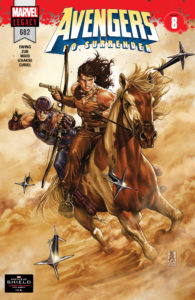
![]() I remain amazed that Marvel has been able to maintain such a high caliber of interior artwork through the first eight issues of this weekly series. I’m not familiar with penciller Sean Izaaske, but he is very good – especially with David Curiel on colors. The combo is a strong follow-up to Kim Jacinto’s brilliant work with Curiel in the past few issues.
I remain amazed that Marvel has been able to maintain such a high caliber of interior artwork through the first eight issues of this weekly series. I’m not familiar with penciller Sean Izaaske, but he is very good – especially with David Curiel on colors. The combo is a strong follow-up to Kim Jacinto’s brilliant work with Curiel in the past few issues.
This is the point in the plot where the characters finally catch up with our knowledge as readers about Earth being a playing board of a massive cosmic game. That reveal is a deliberate plot device from the writing team and it yields a lot of satisfaction throughout this issue as we realize the Avengers are finally on the same page we are.
A lot of the team get interesting business as a result, none more than Lightning and Red Wolf. Lightning is turning into one of the most likable characters on the team. Despite the Avengers heavily featuring a number of younger characters in the past few years, there’s something about his earnestness in finding himself called up to the big leagues that I find endearing. Red Wolf has been on the Avengers sidelines in Occupy Avengers, so I’m not sure what to think about his big moment here. Is it in keeping with his character that he’s a man of intense faith? Or, is this a flat “magical Indian knows all” sort of trope?
There’s also some sciencing with Beast and Wasp, which for me is the weakest part of this plot. Wasp is genius enough on her own to not need validation or a sounding board from Beast, who isn’t being written with particular nuance here. I’d prefer Toni Ho in his spot, or just some random non-science character for Nadia to bounce off of.
The device of the Avengers gaining sudden self-awareness in turn disguises an even bigger plot device, which is that all of this gameboard business has been a distraction from the retconned original Avenger, Voyager. She doesn’t seem to be part of the game, so where did she come from and why was this the right time for her to (re?)appear?
I’m incredibly eager to find out. Marvel has found wild success with this weekly event.![]()
Captain Marvel (2017) #129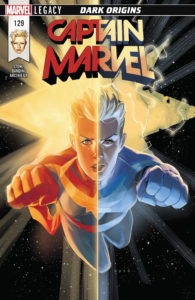
![]() It’s a rough landing for this Captain Marvel series, her fifth in the last six years.
It’s a rough landing for this Captain Marvel series, her fifth in the last six years.
I haven’t been a fan of this alternate reality story, which shunts Carol into a reversed reality where she is a scoundrel who competes with a pirate version of the Guardians to steal things under the nose of a benevolent Thanos. A lot of every issue has been taken up by running gags between Carol and this dim version of Starlord, a pairing which seems to attract writer Margaret Stohl like catnip.
It’s a pity this book had to be in such a rush to meet up with Infinity Countdown, as with another issue or two Stohl really might have been able to add some context that would have made this multi-dimensional arc worthwhile. Just as developments in this issue began to make sense of the overarching story of Stohl’s run, we hit a weirdly rushed ending montage that felt like it was missing a page or two of material, and then BOOM – the story is over and Carol is back to her normal reality.
The real news coming out of this volume is that it was a star-making turn for Michele Bandini, a penciler who turned in consistently beautiful work and nailed the schedule. If Marvel is smart they’ll get her on a major book during Fresh Start. (A big “if.”)![]()
Champions (2016) #17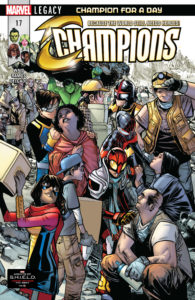
![]() With four new cast members, a Wasp and Vision side plot, and twice the Viv, it’s hard for anyone to find a moment to breathe in this comic, let alone be their own authentic character/
With four new cast members, a Wasp and Vision side plot, and twice the Viv, it’s hard for anyone to find a moment to breathe in this comic, let alone be their own authentic character/
The entire assembled Champions are all fighting a corrupted Viv, though they don’t know it yet. Mark Waid writes a decent confrontation between the two Vivs with a few tense moments, but revisiting the Vision family dynamics in the wake of Tom King’s run is a fool’s errand.
I’m excited to get past this plot beat and see what new lineup shakes out as as result.![]()
Legion (2018) #2
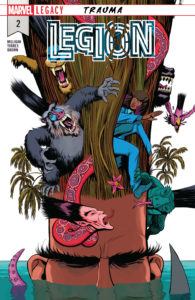
![]() This comic is not about any Legion you’re familiar with.
This comic is not about any Legion you’re familiar with.
Have you been following Legion’s evolution through 2009’s New Mutants and into his 2013 X-Men Legacy series by Simon Spurrier, which finally made Legion’s powers and personality coherent? It’s not even alluded to.
Love the seriocomic tone of the Fox show, with a romantic but terrifying Legion coming to terms with his powers? That’s not present here, either.
This feels like a pre-2009 Legion, still as crazy as ever and completely out of control. And, it’s not even about him. Most of this issue focuses on a young, non-mutant psychiatrist Legion saw on TV and is convinced can resolve his mental trauma.
The result is very little of Legion and a lot of wandering around in Legion’s mindscape (where any number of X-Men would likely fare better). If this comic was an indie book it might seem interesting, but as an exercise in existing IP it’s a failure.![]()
Lockjaw (2018) #1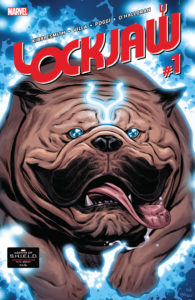
![]() A silly comic book that has a couple of heavy or acerbic points that would be lost on the younger readers it seems otherwise perfect for.
A silly comic book that has a couple of heavy or acerbic points that would be lost on the younger readers it seems otherwise perfect for.
Who knew this would wind up being a Lockjaw and D-Man team-up! The issue is as much about D-Man as Lockjaw, and it spends a lot of time filling in D-Man’s recent past, his depression after breaking up with his boyfriend, and how his sister thinks he attempted suicide.
Like I said, heavy for an ostensibly silly kiddy comic. There’s a hint here of Lockjaw protecting fellow members of his litter, but it’s subtext – considering Lockjaw gets no text.
An amusing book, but not exactly screaming to be on the top of the read pile unless you are an adult Lockjaw devotee who also loved D-Man in Captain America – and I have to think that’s a relatively small overlap in that particular Venn Diagram.![]()
Moon Knight (2017) #192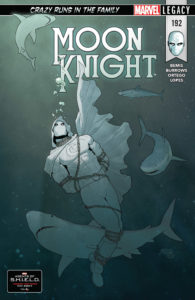
![]() This issue suffers from mid-arc syndrome. It’s solid as a part of the larger story, but as an individual chapter it lacks the madcap fun and reinvention of this run so far.
This issue suffers from mid-arc syndrome. It’s solid as a part of the larger story, but as an individual chapter it lacks the madcap fun and reinvention of this run so far.
It still looks phenomenal – Jacen Burrows is a perfect fit for a bloodier take on Moon Knight. And, this book isn’t bad – it’s still relying heavily on the thematic aspects Bemis set up over the past few issues, including Mark Spector’s subjective view of reality, the value of objective truth to defuse conflicts, and the inherent flaws of superheroism.
Yet, the scenes linking these heady philosophical concepts simply aren’t as strong in this issue – they feel like they are happening because they must occur to support the themes, rather than the story driving the thematic content. This is an issue that will read much better in trade than in a monthly installment.![]()
Thanos (2016) #16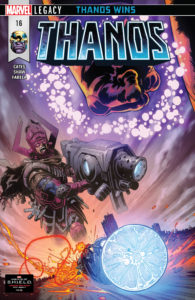
![]() In order to enjoy this Thanos book, you need to come to terms with the fact that it has devolved into pure silliness.
In order to enjoy this Thanos book, you need to come to terms with the fact that it has devolved into pure silliness.
Case and point: a far future Ghost Rider who is not the hero you’d expect to bear the skull and chains, nor to be speaking in a pretty solid Deadpool impression. Here we get to see his threefold faustian deals with three devilish universal forces, each deal more insane and nonsensical than the last.
This leads us back to the far future present and the major battle against an enraged Silver Surfer. Thanos, both present and future, barely factor into this tale. Geoff Shaw fares well with the dark future scenes, but the initial superhero throwdown is a bit gawky.![]()
X-Men: Blue (2017) #22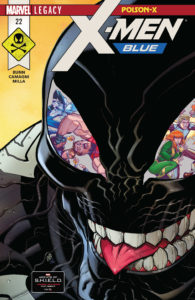
![]() This X-Men and Venom space story rings true for X-Men Blue for the first time in this issue, thanks to some narration from Jean Grey. As she coordinates the team’s break-in to an alien vessel captained by vicious pirate symbiotes, she wonders if the team’s assured, eventual return to the past means they can skate through encounters like this one without a worry.
This X-Men and Venom space story rings true for X-Men Blue for the first time in this issue, thanks to some narration from Jean Grey. As she coordinates the team’s break-in to an alien vessel captained by vicious pirate symbiotes, she wonders if the team’s assured, eventual return to the past means they can skate through encounters like this one without a worry.
That’s exactly the thee that has kept me tuning in to X-Men Blue, but outside of that thread the execution of this book is weak. There are moments where the character say one thing and do something entirely else, causing me to flip back and forth in confusion.
Also, the artwork is high on foreground detail but absolutely bare in the background. It not only feels like there is no established geography to this space ship, but at points the plan color-washed backgrounds make it impossible to tell what is happening in the foreground action. In one case, the interior of a wall of Bobby’s ice is rendered flat black with specs of white, giving the illusion that the team is tossing some prisoners right out into space!
The ending of this issue made me groan, although I should have seen it coming. It turn out this story will have a major impact for Venom and the cosmic fate of the Klyntar race, but it’s predicated on a plot point that I find to be as dull as dishwater.![]()
Smaller Publishers:
Aftershock Comics, Black Mask Studios, Boom! Studios, Dark Horse / Berger Books, Titan Comics / Statix Press
Abbott (2018) #2, Boom! Studios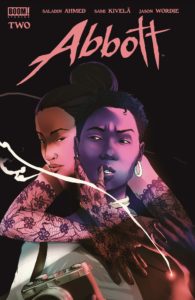
![]() Much like the last issue of this Ahmed period piece set in early 1970s Detroit, most of this book is a workmanlike journalism procedural that feels like a failed TV pitch because it relies so heavily on its lead character being performed with charm that doesn’t come across in the script.
Much like the last issue of this Ahmed period piece set in early 1970s Detroit, most of this book is a workmanlike journalism procedural that feels like a failed TV pitch because it relies so heavily on its lead character being performed with charm that doesn’t come across in the script.
There are terrific bursts of supernatural at the start and at the close, and the final frames here convince that the mutilated horse and murdered young black man last issue were part of the same problem. Yet, this issue is still playing it hopelessly oblique about Abbott’s ex-husband and her tie to the supernatural. This is a finely made comic, but it’s not holding up very well in monthly installment.![]()
Alisik (2018) #1, Titan comics / Statix Press
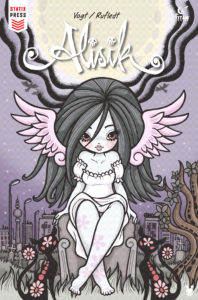
![]() This European album-style issue (it’s 60 pages!) looks like a Tim Burton stop motion movie illustrated by comic artist Clayton Crain.
This European album-style issue (it’s 60 pages!) looks like a Tim Burton stop motion movie illustrated by comic artist Clayton Crain.
We follow a newly post-mortem being (i.e., DEAD PERSON) named Alisik as she comes to terms with being a ghost and gets to knows the group of misfit Post-Mortems with whom she shares a cemetery. She has little memory of herself or her life, and is nothing like the animated characters who surround her. Will she settle in to her life after death, or is there something different about her?
This book is beautiful and full of mystery, including who Alisik was before she died and what (if anything) the afterlife holds beyond the cemetery. I loved the blithe, befuddled take on Charon, who makes social calls to the cemetery but isn’t sure about who is meant to cross over to the other side.
I am definitely looking forward to reading more – even as a picture-book with no words this would be fascinating.![]()
Backways (2017) #3, Aftershock Comics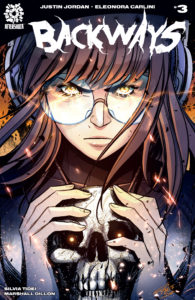
![]() I’m not going to lie – I had to re-read all of issue #2 to remind myself what was going on this crazy, fast-moving world of magic and fantastic powers that lives as the underside to the normal life we all live.
I’m not going to lie – I had to re-read all of issue #2 to remind myself what was going on this crazy, fast-moving world of magic and fantastic powers that lives as the underside to the normal life we all live.
Even with the last issue fresh in my mind, I think this issue was a bit hard to follow. I’m not sure if it was a discontinuity in the marriage of the script to the art, or maybe something about the lettering and balloon placement. At points I really struggled to understand what was happening in the chase and confrontation with the big bad wolf.
Yet, in the grander story there is something very interesting happening: the potential return of the great destroyer of the Backways world, and one who doesn’t even want to be there. Can her fate be averted? Can she decide to leave and go back to the real world? And, how would the quorum deal with her, with the memory of the last wave of destruction still fresh in their memories?
The backstory potential of this world combined with the gloriously colorful art keeps the appeal of this book high, even if the story is a bit splintered in this issue.![]()
Calexit (2017) #2, Black Mask Studios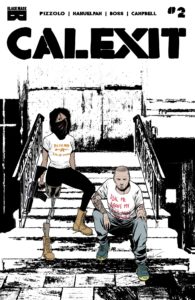
![]() The first issue of Calexit was out way back in July 2017, which in United States political news feels like an entire decade ago. It is about a United States that hasn’t decayed as far as the one in Kot’s Days of Hate. The book supposes that the American decline continues on its obvious path, and results in the state of California torn between communities wanting to succeed and law and order folks who want to remain.
The first issue of Calexit was out way back in July 2017, which in United States political news feels like an entire decade ago. It is about a United States that hasn’t decayed as far as the one in Kot’s Days of Hate. The book supposes that the American decline continues on its obvious path, and results in the state of California torn between communities wanting to succeed and law and order folks who want to remain.
Even if you remembered what happened in the first issue (which was at points hilarious and grim), there’s not much here for you. There is the necessary disposal of a Steve Bannon character, since the same happened in real political life (thought that’s not an excuse enough for a seven month wait between issues). We also see the heartless fallout from the gun battle at the end of issue one. It makes our revolutionaries come off just as vile as the tyrannical government.
Making the revolutionary movement unsympathetic (or, at least, shockingly violent) provides some balance to this narrative and gives us a reason to linger on the autocratic forces at they plan their revenge. That has two implications – both true, and both uncomfortable.
First, there is the idea that resistance cannot come without sacrifice. Resistance isn’t tweets, and phone calls are just the tip of the iceberg. We see people die here for shielding others from immigration raids and hear about acceptable losses. The Calexit resistance understands that they are engaged in way, and they cannot linger on the microcosm of any one death. That’s not how successful revolutionaries won the day in other countries. The Calexit forces cannot afford to play a game of slow attrition and changing hearts and minds. Some pawns will be sacrificed and they are unafraid to look bad for sacrificing them.
That is a harsh truth to digest, and depending on your personal views on war in general and revolution in specific it might make it impossible to root for the resistance here.
Yet, beyond that, there is the second implication – that leaders of a revolution are likely just as unlikable as the leaders they are revolting against. Not everyone gets to be Mel Gibson in Braveheart. These things aren’t always easy or pretty. Yet, in the context of a comic criticizing the current political climate, making the resistance easy to dislike as characters rather as a movement stinks of both-sides-ism.
I enjoy that this comic looks so incredibly good and makes me ponder such deep thoughts, but there is imminent danger of it becoming a philosophy lesson rather than a good story when the only character to mildly root for is the quick-mouthed courier we met in the first issue. For a comic so tapped into the current zeitgeist and so well-crafted, I wish it could be more engaging.![]()
Hungry Ghosts (2018) #2, Dark Horse / Berger Books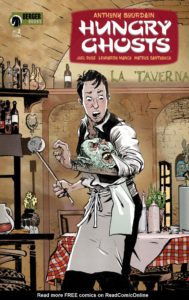
![]() This series is a culinary ghost story anthology with a light weight framing device.
This series is a culinary ghost story anthology with a light weight framing device.
The tales in this issue are beautifully illustrated – I think it’s better-looking than the first.
The first is mostly a gross-out equine smorgasbord with a ghostly ending. The second is more of a farce that starts out as an allegory and peters out with a touch of comedy. Neither are especially memorable or scary. The intrigue of the room full of chefs telling these teals is minimized down to just a pair of framing pages.
While this comic is clearly lovingly made, it’s hard to see the appeal of it past Bourdain’s name on the cover.
![]()
Jim Henson’s Labyrinth: Coronation (2018) #1, Boom! Studios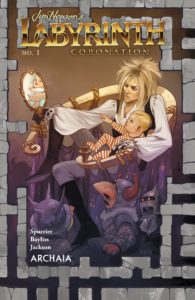
![]() A beautiful set of misdirections from Simon Spurrier, who is at his most slick and subdued here as he reverently handles Jim Henson’s legendary David Bowie vehicle. While this introductory issue is light on the labyrinth itself, it carries many shades of implication for how the petulant Jareth became the Goblin King that we know and lust over.
A beautiful set of misdirections from Simon Spurrier, who is at his most slick and subdued here as he reverently handles Jim Henson’s legendary David Bowie vehicle. While this introductory issue is light on the labyrinth itself, it carries many shades of implication for how the petulant Jareth became the Goblin King that we know and lust over.
So far this feels like it’s for Labyrinth fans only, but it has the potential to blossom into something that can stand alone. While I’m not all for revisiting every media property to make a prequel, I think the craft of this comic is sturdy enough to continue reading.